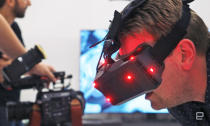The best way to customize a supercar is in VR
You know what’s cooler than a real car? A virtual supercar.
To paraphrase Robin Williams, buying a $2.8 million supercar is God's way of telling you that you're making too much money. And yet there's a certain thrill in picking out the red leather trim that goes so well with a black carbon-fiber shell. Because that's what I picked to trick out the Pagani Huayra I could buy if I had Zuckerberg-level money. It's also the same way that members of the super rich will customize their own rides soon.
The idea is that car showrooms of the future will be little more than a couple of neat chairs and a VR studio at back. Rather than forcing bored billionaires to browse swatches and paint charts, they'll allow billionaires to do it all while hooked up to a computer. That's not to mention that inside the virtual world, you can also place your new whip in a variety of environments to check that it suits. After all, you don't wanna spend three big ones on a car only to find it doesn't look good in California's Death Valley.
You can't simply strap any old VR headset onto the head of the Bloombergs or Buffets of this world, however. Only the ones produced by StarVR, the partnership between Starbreeze and Acer, will do. The biggest selling point of the kit is its 210-degree field of vision, a far cry from the FOVs available with the Oculus (110 degrees), Vive (110 degrees) and PSVR (101 degrees). That extra space is, of course, designed to further immerse you, and your peripheral vision, in whatever you're looking at.
ZeroLight is the company that actually produces the photo-realistic, high-definition digital models of the vehicles. It's working with a variety of automotive manufacturers to create the virtual showroom of the future.

Once you're strapped in, you're placed on a cliff edge in scenic America with the Huayra standing in front of you. Floating over to one side is a virtual menu that lets you customize the car. Top of the list is the paint job and body options, followed by the wheels, before you get to the interior choices. When you're finished, you can transport the car to a number of locations, including the Pagani factory floor and California. You know, just to make sure that it doesn't look ugly as hell under the strong desert sun.
As part of the deal, the ZeroLight models double as engineering diagrams, and would-be users can even "explode" the model to study every component in isolation. The StarVR headsets, meanwhile, do at least offer unprecedented levels of immersion. When the picture envelops your whole head in this manner, it's far easier to get lost in the world than before. A couple of times I tried to lean on the car before self-consciously catching myself, knowing that I was in the company of seven other people in an otherwise empty room.
Virtual cars might not be to everyone's taste, especially those folks who relish pawing through swatch books. But given that StarVR's system can scale to almost any size, it could -- potentially -- accommodate the ability to sit in your own virtual car. As long as the showrooms provide blank chairs for these people to actually rest upon -- we'd hate for those super rich people to try to sit on a virtual car and crash onto the floor.
Mat Smith contributed to this report.
Follow all the latest news from IFA 2017 here!










